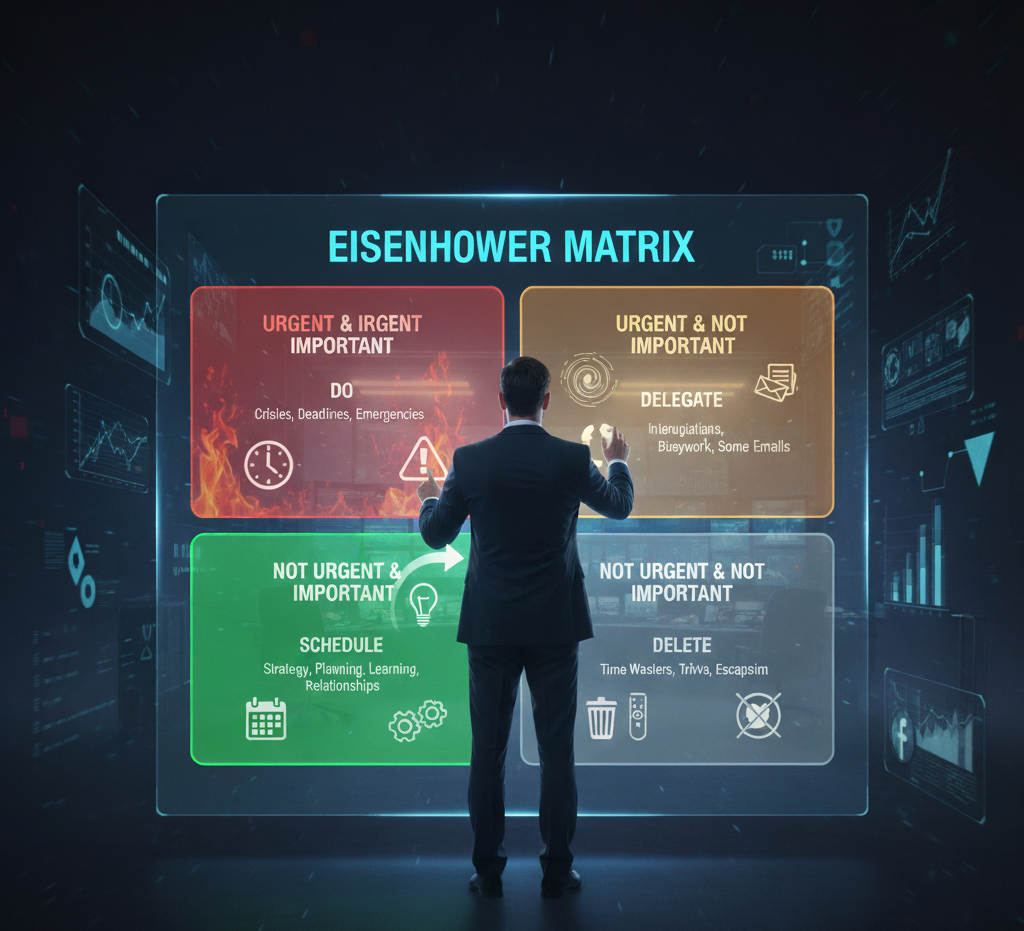
Explanation:
The Eisenhower Matrix is a time management tool that helps you prioritize tasks by sorting them into four quadrants based on their urgency (requires immediate attention) and importance (contributes to long-term goals).
Example:
Responding to a sudden client crisis is Urgent & Important (Do), while blocking out time for strategic planning for next year is Not Urgent & Important (Schedule).
Insight:
The most crucial insight is that effectiveness comes from proactively scheduling and focusing on “Important but Not Urgent” tasks, as this is the only way to prevent them from becoming future “Urgent & Important” crises.
Stop Firefighting, Start Leading: Mastering the Eisenhower Matrix
Leaders often find themselves saying, “I am busy all day, but I feel like I get nothing done.” They spend their time lurching from one “fire” to the next, stuck in a constant state of reaction. They are great firefighters, but they aren’t making any progress.
The problem isn’t their work ethic; it’s their operating system. They are being tricked by urgency.
This is the exact problem the Eisenhower Matrix, famously used by President Dwight D. Eisenhower, is designed to solve. He famously said, “I have two kinds of problems, the urgent and the important. The urgent are not important, and the important are never urgent.”
This model forces you to separate these two easily confused qualities.
- Urgent tasks are time-sensitive. They demand your immediate attention. A ringing phone is urgent. A notification pop-up is urgent. They are almost always reactive.
- Important tasks contribute to your long-term mission, values, and goals. They are almost always proactive and require planning.
The matrix plots these on a simple 2×2 grid, giving you four quadrants for your “to-do” list.

The Four Quadrants
1. Quadrant 1: Urgent & Important (Do)
These are the fires, the true crises, the non-negotiable deadlines. Examples include a server being down or a major client complaint. You must do these tasks now. The problem is, many people spend their entire day here. This is the zone of managing.
2. Quadrant 2: Not Urgent & Important (Schedule)
This is the “magic quadrant.” It’s the most neglected but the most valuable. This quadrant includes strategic planning, learning a new skill, building relationships with your team, and taking care of your health. These tasks are never “on fire.” No one will ever yell at you for not doing them today. But this is the zone of leadership and growth. The more time you spend here, the fewer Q1 fires you’ll have to fight.
3. Quadrant 3: Urgent & Not Important (Delegate)
This is the quadrant of deception. These tasks feel important because they are time-sensitive, but they don’t contribute to your core goals. Examples include many “urgent” emails, pointless meetings you were invited to, or a colleague asking for a “quick favor” that isn’t your responsibility. The solution: Delegate, automate, or politely decline.
4. Quadrant 4: Not Urgent & Not Important (Delete)
This is the zone of waste. These are the time-wasters, the trivial tasks, the mindless social media scrolling. The rule here is simple: Eliminate them.
The goal of the Eisenhower Matrix isn’t just to sort your tasks. It’s a strategic tool to help you consciously shift your time. It’s your filter to move away from being a Q1/Q3 firefighter and to become a Q2 architect.
